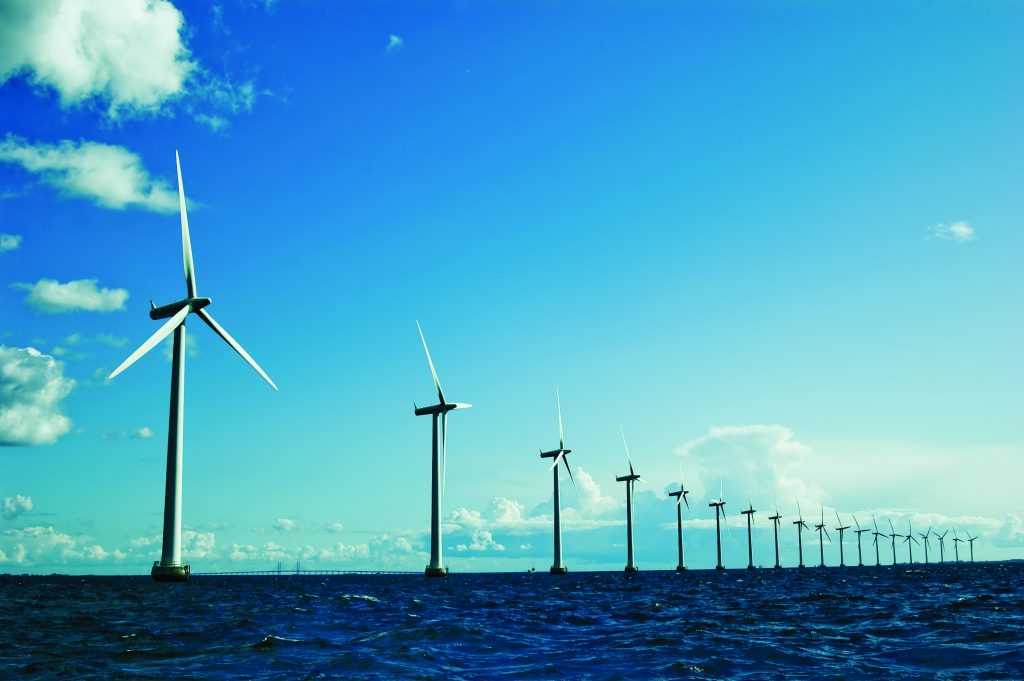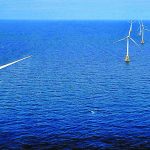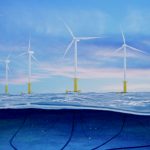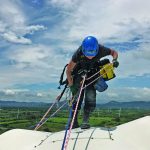It may be easy to look at spinning wind turbines and not be in awe of the plethora of hoops developers have to jump through before an asset ever starts producing power.
But regulations are a fact of life for almost any massive project, and wind farms, both offshore and on land, are proving to have even more hurdles to overcome.
Lessons have been learned as the U.S. takes baby steps to generating electricity with offshore wind turbines, but that building knowledge is slowly coming together.
In a recent panel hosted by AWEA in Albuquerque, New Mexico, industry representatives came together to discuss regulatory reform and what it means for U.S. wind projects.
One of those experts was Hilary Tompkins, former Solicitor of the Interior in the Obama administration under Secretaries Ken Salazar and Sally Jewell and now a partner with Hogan-Lovells in Washington, D.C.
“We talked about issues that the industry confronts with the federal regulatory and permitting requirements, and the challenges that they face and ways in which we can maybe help streamline those processes and simplify the amount of data that’s required,” she said. “There are very lengthy, time-consuming, and costly environmental and cultural resources reviews that the wind industry has to go through in order to launch a project.”
Help comes in 2005
The EPAC Law Energy Policy Act of 2005 opened the doors to authorize renewable energy development on public lands and public waters, and the Obama Administration’s Department of the Interior finalized regulations in 2009 to implement those laws, according to Tompkins.
“We were also coming at a time where the legal regime was being established, and we were in the boat of launching these first projects on public lands,” she said. “That’s how I really got started.”
Even though more privately-owned lands — mainly through green-driven companies — have taken a strong lead in developing wind energy, the use of public lands, and even tribal lands, is important to getting assets up and spinning, according to Tompkins.
“Public lands are an untapped resource; there’s a lot of capacity,” she said. “But I do think there are things that could be improved to make it more hospitable for the realities of launching a utility-scale commercial project. And one of the things we did under the last administration was a fast track renewable energy project initiative.”
Strong leadership in federal areas that include the Department of the Interior, and its offices such as the Bureau of Land Management, the Bureau of Ocean Energy Management, the Fish and Wildlife Service, and others are going to be key in building those opportunities, according to Tompkins.
“This applies even if you have a private land project; sometimes other federal requirements get triggered,” she said.

Tracking projects with tech
Advancements in technology also will be paramount in keeping track of all the multiple facets of a project’s development, according to Tompkins.
“We need really current and sophisticated databases with all of the wildlife and environmental information in electronic format that is constantly updated, along with all the new mapping tools that are becoming more available,” she said. “I really see that as something the government should invest in and consider doing.”
That’s important for projects that are outside public lands, too, because often some federal resources can be triggered for legal review, according to Tompkins.
“The more we move into a digitized age with all these environmental reviews, I think the faster we can move through the environmental review process,” she said. “When I was Solicitor at Interior, the lawyers would get different NEPA documents in different formats with different information from various parts of Interior. We had to spend a lot of time redrafting those documents and recompiling the information. It was just not streamlined or efficient. And, certainly, for my former legal team, it was really challenging and time consuming.”
Congressional support
Of course, in order for a database of this nature to become a reality, it will take an act of Congress — literally, according to Tompkins.
“I think it takes Congress supporting the funding needed to bring all of that information into the 21st century,” she said. “It would also take leadership and the political will to harmonize those reviews and make sure that they’re not duplicating effort. The current administration is trying to do that with the fossil-fuel industry, but it really takes creating systems that can compile all that information, analyze it, and churn out conclusions and documents that can support the agency’s actions in a nimble and streamlined way — even between federal agencies.”
With the fossil-fuel industry already taking advantage of a growing database, it brings up the possibility of industries clashing over the same piece of land, but Tompkins said, surprisingly, that wasn’t the case.
“It’s identifying where on the public lands you want fossil fuels and what areas are most hospitable for renewables and if they are distinct, and we found there was — more often than not — no overlap,” she said. “I do think we were at the tip of the iceberg of doing landscape scale regional renewable planning, like the desert renewable energy conservation plan and the solar PEIS. We were trying to get to wind, but we ran out of time.”

Lessons learned
Looking back at the first offshore wind project with Cape Wind exposes a lot of important lessons that were learned when it was time to move on to the next project, according to Tompkins.
“We learned how to not only coordinate internally with BOEM and the Fish and Wildlife Service, but also with the FAA, NOAA, and the Department of Defense,” she said. “There are so many layers just on the federal family side that you need to be sure are coordinated and that you’re on top of all the various federal review components. Streamlining that process is going to be key.”
A programmatic land management planning approach could help ease potential complications, which is what’s happening for offshore Atlantic, according to Tompkins.
“After that challenging experience of Cape Wind, the Interior Department learned its lesson, and they carved out big wind-energy areas where they had determined the conflicts were less and less likely to have legal challenges,” she said. “That’s the current regime we’re in now.”
Recently, the Bureau of Ocean Energy Management (BOEM) identified large geographic regions and auctioned off leases where regions will undergo site assessment to determine the proper spots for future wind projects, according to Tompkins.
“It’s a phased approach looking at site assessment,” she said. “If you clear that hurdle — which is a multiyear assessment hurdle — then you move into the construction phase, and you only have to do the really heavy-duty environmental review in the construction phase of your wind project. Hopefully, that gives the industry some comfort that those areas offshore have passed some court review.”
Addressing climate change
Part of streamlining regulations will certainly involve climate change as a talking point, but Tompkins feels like, even though it’s an important crisis to be addressed, the development of more renewables won’t necessarily rely on federal policy on that issue in order to grow.
“Even if you don’t believe in climate change, the realities of state climate energy targets are real, and the industry’s going to respond to that and will be driven to meet those targets regardless of what the federal policy is,” she said. “And I also think that, economically, we’re seeing an increase in the amount of renewables and a decrease in the cost of renewables along with natural gas, of course. But I think those market dynamics will show an incentive or create an incentive to support renewables. And then we’re also seeing utilities declaring major renewable energy commitments along with corporate America, who are making commitments about buying renewable energy in significant amounts. All of those market dynamics will support the growth of renewables regardless of your views on climate change.”
Cape Wind faced a lot of obstacles, including local support for its location, it being a historical area, and there were Indian tribes that had cultural connections with the ocean and the horizon, according to Tompkins. There were also shipping lane concerns.
“There was just a lot opposition and resistance to having that project in the location it was sited,” she said. “And that made it really, really challenging. I think the other lesson we learned is understanding all the different federal components and authorities, meaning the different federal agencies that need to sign off on a project like that. Doing that in a way that does not create delays is really important. We also learned, and all of this was in litigation, that we were trying to streamline, and there were some things that we had BOEM do that the court said, ‘No, you can’t outsource that to BOEM. That’s what the Fish and Wildlife Service does.’”
Knowing when to streamline
The biggest takeaway was that streamlining can be effective, but too much streamlining too quickly can sometimes have the opposite effect, according to Tompkins.
“What we learned is you can try and fast track; you can streamline, there are ways to sequence all of those reviews and the different governmental approvals,” she said. “But you can’t take too many shortcuts, because then you can end up in court with a judge saying you have to go back and fix things. That’s what happened with Cape Wind. It’s always tough being the first, but I think we learned a lot from it, and we can use that knowledge to help avoid those issues in the future.”
And that next project was the Block Island Wind Farm off the coast of Rhode Island.
“It’s in the same region, but it’s in a completely different area,” Tompkins said. “And if you look on a map, it was in an area that had less impact and less likelihood of opposition. And that was purposeful. That’s an example of how the knowledge from Cape Wind helped inform the next one. I think that’s a hopeful message for folks that we are moving in a more informed direction moving forward.”
That also shows how wind energy is getting savvy about community engagement and building a local awareness and support for projects, according to Tompkins.
“I also think we’re finding that wind is becoming a very valuable source of energy in rural America where, not only is it providing energy, but it’s also a significant income in terms of tax payments to local governments and states and lease payments to private-property owners,” she said. “There are real benefits on the ground to local communities that we’re seeing and, in particular, in these remote areas. There’s been a lot of support in that regard.”
Wind on tribal lands
Tompkins also feels that an, as yet mostly untouched, resource for wind projects can be found on tribal lands.
“I think it’s not happening because folks might not feel comfortable reaching out into Indian country and understanding the legal regime and the different issues that arise when you’re working on a project in Indian country,” she said. “But let me tell you, I think it’s an untapped opportunity. The wind belt in the United States covers a lot of Indian lands, and under the last administration, we passed new regulations to help streamline renewable projects and wind projects, in particular, on tribal land. So, it’s a great opportunity. I am highly supportive and interested in finding those opportunities. It’s a part of my focus now that I’m out of the government to bridge that gap that seems to be there between tribes and the wind industry.”
Already, in some tribal areas, fossil fuels are being switched to renewables, according to Tompkins.
“They have fossil-fuel development on their lands, and they’re interested in converting, and also they need power,” she said. “Many tribes don’t even have basic electricity in their homes, which I find appalling in this day and age. There’s also a social responsibility component to exploring opportunities to build renewables in Indian country. I think renewables and the low impact that they have on greenhouse gas emissions, for instance, are the sorts of things that are very in sync with Native American culture and values.”
Infrastructure and the supply chain
Another important piece of the regulatory puzzle is making sure the right infrastructure, as well as an upgraded supply chain, is in place, because that can involve a lot more tap dancing than one might think, according to Tompkins.
“You need to figure out how to connect from the federal waters into the coastal areas of the Atlantic,” she said. “And one of the things we found at Interior was how critical it was to engage with the state governors and ensure that where we were siting projects made sense in terms of an offtake into the state system and ensuring, too, that their proposals for buying power are in sync with the timing in place of federal opportunities to build the power. There’s a lot of coordination and cart-before-the-horse issues that you need to think about before you launch and be sure that the federal government is speaking, not only within that big federal family, but also with the state governments and the local communities and the interstate transmission systems that exist.”
It boils down to, essentially, reading the grid and having a system that can embrace different forms of electricity, while supporting research and development, new technologies, and the long-term storage of renewable power, according to Tompkins.
“It’s like when you’re building any national infrastructure project — be it bridges or highways or hydropower dams,” she said. “We’ve done it before, and I think it’s just a matter of saying: This is a priority, and we need to upgrade the grid to reflect the changing nature of energy.”




































